Practice with the help of enVision Math Common Core Grade 1 Answer Key Topic 14 Reason with Shapes and Their Attributes regularly and improve your accuracy in solving questions.
enVision Math Common Core 1st Grade Answers Key Topic 14 Reason with Shapes and Their Attributes
Essential Question:
How can you define shapes and compose new shapes?

Find Out Talk to friends and relatives about everyday objects that have special shapes. Discuss how the shape is important for its use.
Journal: Make a Book Show what you found out. In your book, also:
- Draw different buildings using circles, squares, rectangles, cylinders, and rectangular prisms.
- In your drawings, show how shapes can be put together to make new shapes.
Review What You Know
Vocabulary
Question 1.
Scott sorted these shapes. Put an X on the one that does not belong.

Answer:

Explanation:
In the above image we can observe 4 shapes one is square, second is rectangle, third is also rectangle and fourth is circle. Both Square and rectangle have four edges and four vertices. Circle has 0 edges and 0 vertices. So draw X on the circle which is different from the above three shapes.
Question 2.
Circle the object that is a different shape.

Answer:

Explanation:
In the above image we can observe four shapes. First shape is different from the remaining three shapes. So circle first shape.
Question 3.
Circle the triangle.

Answer:

Explanation:
In the above image we can observe four different shapes one is circle and second one is rectangle and third is square, fourth is triangle. A triangle is a polygon with three edges and three vertices. It is one of the basic shapes in geometry. Here we have to draw a circle for triangle. So draw a circle for triangle.
Same and Different
Question 4.
Draw a shape that is the same as the one below.

Answer:

Explanation:
Here we have to draw a shape that is same as the one above in the question. We can observe the circle shape in the above image. So drawn a circle shape which is similar to the above image.

Question 5.
Draw a shape that is different from the one below.

Answer:

The above shape is right angled triangle which is different from the above shape.
Explanation:
Here we have to draw a shape which is different from the square shape. In geometry, a square is a regular quadrilateral, it has four equal sides and four equal angles. It can also be defined as a rectangle in which two adjacent sides have equal length.
Here I drawn right angled triangle. A triangle is a polygon with three edges and three vertices. It is one of the basic shapes in geometry.
C1ount by 1s
Question 6.
Write the missing numbers.
1, ______, 3, 4, _______
Answer:
1, 2, 3, 4, 5
The missing numbers are 2, 5
Explanation:
In the above number series we can observe 1, ______, 3, 4, _______. We have to find the missing numbers in the series. The missing numbers are 2, 5. The number series is 1, 2, 3, 4, 5.
Pick a Project
PROJECT 14A
Have you ever seen a building this crooked? Project: Build a Strong Tower

PROJECT 14B
Where can you see your reflection? Project: Reflect Shapes

PROJECT 14C
How can lots of little tiles make one big piece of art? Project: Design a Tile Picture

PROJECT 14D
What is a robot?
Project: Design and Build a Robot

Lesson 14.1 Use Attributes to Define Two Dimensional (2-D) Shapes
Solve & Share
Tell how the 4 shapes are alike. Tell how the 4 shapes are different. Use a measuring tool to help..

I can … use attributes to describe shapes.
Visual Learning Bridge

Convince Me! Look at the blue triangle above. How would you define it by how it looks?
Guided Practice
For each shape, tell how many straight sides or vertices, and if it is closed or not.
Question 1.

Answer:

Explanation:
In the above image we can observe trapezium shape. A trapezium is a quadrilateral, which is defined as a shape with four sides, which has one set of parallel sides. The trapezium is basically a types of quadrilaterals, with exactly one pair of parallel sides. Trapezium has four straight sides and it is a closed shape.

Question 2.

How many vertices? ________
Closed? _______
Answer:
There are 2 vertices for the above image.
The above image is not a closed shape.
Explanation:
The above shape is not a triangle because it is not a closed shape and it has 2 vertices.
Question 3.

How many straight sides? __________
Closed? ___________
Answer:
The above shape is hexagon. It has 6 straight sides.
The above shape is a closed shape.
Explanation:
The above shape is hexagon. Hexagon is a closed geometric figure having six angles and six sides. It has six straight sides and it is a closed shape.
Independent Practice
Draw each shape.
Question 4.
Draw a closed shape with 3 vertices.
Answer:

Right angled triangle is a closed shape with three vertices.
Explanation:
A Right angled triangle is a closed shape with three vertices. A triangle is a polygon with three edges and three vertices. It is one of the basic shapes in geometry.
Question 5.
Draw a closed shape with 0 straight sides.
Answer:

Circle is a closed shape with 0 straight sides.
Explanation:
Circle is a closed shape with 0 straight sides. It is one of the 2D shapes.
Question 6.
Draw a closed shape with more than 3 vertices.
Answer:

Square is a closed shape with more than 3 vertices.
Explanation:
Square is a closed shape with more than 3 vertices. In geometry, a square is a regular quadrilateral, which means that it has four equal sides and four equal angles. Square has 4 vertices and a closed shape.
Question 7.
Circle the closed shapes.

Answer:

Explanation:
In the above image we can observe different types of shapes. Some are closed shapes some are not closed shapes. The closed figures are triangle, circle, and parallelogram. So draw a circle for the closed shapes.
Question 8.
Higher Order Thinking Look at the shapes in each group. Explain how the shapes are sorted.

Answer:
In Group 1 all triangles are sorted with different shape and size. And all triangle shapes are closed figures.
In Group 2 only two shapes are closed figures. The closed shapes are circle and hexagon. Remaining two shapes are not closed shapes.
Problem Solving
Solve each problem below.
Question 9.
Be Precise Circle 3 shapes that have the same number of vertices and sides.

Answer:

Explanation:
In the above image we can observe different types of shapes. The shapes are Hexagon, rectangle, square, triangle, circle. Square and rectangle have four sides and four vertices. Draw a circle for square and rectangle.
Question 10.
Be Precise Circle 3 shapes that do NOT have any vertices.

Answer:

Explanation:
In the above image, we can observe different types of shapes. There are hexagons, squares, circles, and rhombus. Hexagon has six vertices and the square has four vertices, the circle has no vertices, and the rhombus has four vertices. So draw a circle for circle shape.
Question 11.
Higher Order Thinking Think about a 2-D shape. Write a riddle about the shape for a partner to solve.
Answer:
Question 12.
Assessment Practice I have 6 vertices. I am a closed figure. Which shape or shapes can I NOT be? Choose three that apply.

Answer:
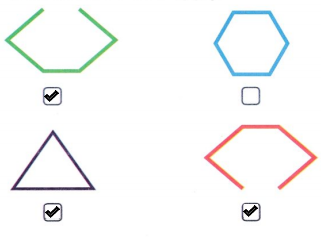
Explanation:
In the above image, we can observe two closed shapes and two open shapes. The closed shapes are hexagon and triangle. Hexagon has 6 vertices and a closed figure. But here asked the shape should not be a hexagon. So select the remaining three shapes.
Lesson 14.2 Defining and Non-Defining Attributes of 2-D Shapes
Solve & Share
Tell how the 5 shapes are alike. Tell how the 5 shapes are different. Use a tool to help.

I can … define 2-D shapes by their attributes.
Visual Learning Bridge

Convince Me! Why is this shape NOT a square?

Answer:
It’s a rectangle.
Explanation:
The shown image is not square, because the image shows opposite sides are parallel which represents a rectangle.
Guided Practice
Circle the words that are true for Practice the shape.
Question 1.

are blue.
have 4 equal sides.
are closed shapes.
are small.
have 4 square corners.
Answer:

Explanation:
In the above image we can observe two square shapes. Draw a circle for these words. All squares have 4 equal sides. All squares are closed shapes and all squares have 4 square corners.
Independent Practice
Circle the words that are true for each shape.
Question 2.

All triangles:
are orange.
have 3 sides.
have 3 equal sides.
are tall.
are closed figures.
Answer:

Explanation:
In the above image we can observe a triangle. Draw a circle for these words. All triangles have 3 sides and all triangles are closed figures.
Question 3.
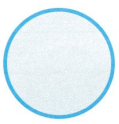
All circles:
are blue.
have 0 vertices.
are small.
have 0 straight sides.
Answer:

Explanation:
In the above image we can observe a circle. Draw a circle for these words. All circles have 0 vertices and all circles have 0 straight sides.
Question 4.
Higher Order Thinking Tim says that this is a rectangle. Is he correct? Tell why or why not.

Answer:
The above image is not a rectangle because it is not a closed shape.
Explanation:
Rectangle is a plane figure with four straight sides and four right angles, especially one with unequal adjacent sides, in contrast to a square. The rectangle is a closed figure. The above image is not a closed figure so the above shape is not a rectangle.
Problem Solving
Solve each problem below.
Question 5.
Use Tools Do all rectangles have equal sides? Circle Yes or No.
Yes
No
Choose a tool to show how you know.
Answer:
No.
Explanation:
No, all rectangles do not have equal sides.
Question 6.
Higher Order Thinking Jake says both of these shapes are hexagons because they are closed, have 6 straight sides, and are red. Do you agree? Explain.

Answer:
Hexagonal shape is a two-dimensional geometrical shape which is made of six sides, having the same or different dimensions of length. Hexagon is a closed figure.
The above shapes are hexagons. Hexagon is a closed shape and it has 6 straight sides. Color, overall size, or position do not define a shape. So I am not agree with Jake.
Question 7.
Assessment Practice Tanya says that this shape is NOT a square. Do you agree? Circle Yes or No.
Yes
No
Explain why or why not.

Answer:

The above image is a square.
Explanation:
A square is a regular quadrilateral, which means that it has four equal sides and four equal angles. It can also be defined as a rectangle in which two adjacent sides have equal length. The above shape is square because it has four equal sides.
Lesson 14.3 Build and Draw 2-D Shapes by Attributes
Solve & Share
Find square corners and rectangle shapes in the classroom. Tell your partner why a shape you find is a rectangle. Count how many square corners you find. Use the chart to help keep track.

I can … use different materials to make shapes.
Visual Learning Bridge

Convince Me! Sue made the gray shape on the right. Is it also a hexagon? Tell how you know.
Guided Practice
Make a square. Use materials your teacher gives you. Glue or tape the square in the box. Explain how you know it is a square.
Question 1.
Answer:
As we have glued the square in the box and all the sides are equal. So we know it is a square.
Independent Practice
Use materials your teacher gives you to make each shape. Glue or tape the shape in the box. Explain how you know the shape is correct.
Question 2.
Make a circle.
Answer:
Question 3.
Make a rectangle.
Answer:
Question 4.
Higher Order Thinking Carlos made the shapes below. He says they are both squares. Is he correct? Explain.

Answer:
Carlos is not correct because in the above two images first, one is the square and the second one is a rectangle.
Explanation:
The first shape is square because the square is a regular quadrilateral, which means that it has four equal sides and four equal angles. It can also be defined as a rectangle in which two adjacent sides have equal length.
The second shape is a rectangle because it is a plane figure with four straight sides and four right angles, especially one with unequal adjacent sides, in contrast to a square.
Problem Solving
Draw a picture to solve each problem below. Use pattern blocks to help you.
Question 5.
Reasoning Sandy makes a closed shape with 4 equal sides. What shape did she make?
Draw the shape Sandy made.
Answer:

Sandy made a square shape. It is a closed shape with 4 equal sides.
Explanation:
Sandy made a square shape because it is a closed shape with four equal sides. A square is a regular quadrilateral, which means that it has four equal sides and four equal angles. It can also be defined as a rectangle in which two adjacent sides have equal length
Question 6.
Reasoning Miguel makes a closed shape with 3 straight sides and 3 vertices. What shape did Miguel make?
Draw the shape Miguel made.
Answer:

Miguel made a triangle. It is a closed shape with 3 straight sides and 3 vertices.
Explanation:
Miguel made a triangle. Because it is a closed shape with 3 straight sides and 3 vertices. A triangle is a polygon with three edges and three vertices. It is one of the basic shapes in geometry.
Question 7.
Higher Order Thinking Use a piece of paper to make a square. Then turn the square into a triangle. What did you do? Explain.
Answer:
We have turned the square into a triangle.
Question 8.
Assessment Practice Mark wants to use straws to make a hexagon. Use the dots to draw straight lines that show Mark how the hexagon would look.

Answer:
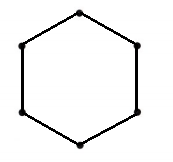
Explanation:
Mark used the dots to draw straight lines to draw the hexagon. The hexagon shape is a two-dimensional geometrical shape that is made of six sides, having the same or different dimensions of length. Here Mark drew the hexagon with the help of dots and straight lines.
Lesson 14.4 Compose 2-D Shapes
Solve & Share
Use ![]() shapes to make a
shapes to make a  . Write how many of each shape you use. Then add the three numbers to find how many pieces in all. See if you can make the hexagon with less than 15 pieces in all!
. Write how many of each shape you use. Then add the three numbers to find how many pieces in all. See if you can make the hexagon with less than 15 pieces in all!
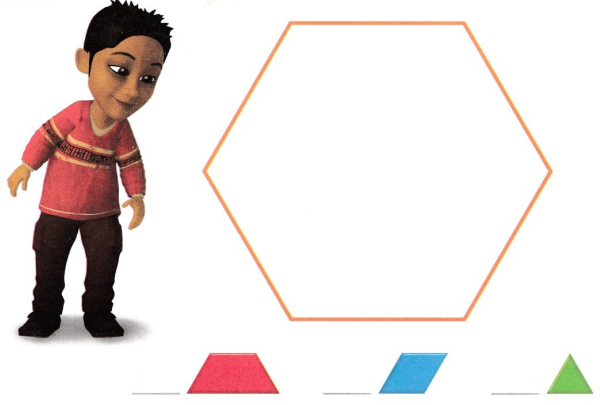
________ pieces in all
I can .. put shapes together to make another shape.
Visual Learning Bridge

Convince Me! How can you make a large shape using smaller shapes?
Guided Practice
Use pattern blocks to make the large triangle shape.
Question 1.
Complete the chart.

Answer:
Independent Practice
Use the smaller shapes to make larger shapes.
Question 2.
Complete the chart to show a list of ways you can make the hexagon. Use pattern blocks to help.

Answer:
Question 3.
Use  to make a
to make a 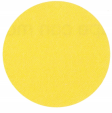 . Draw the
. Draw the  in the space below.
in the space below.
Answer:
Question 4.
Higher Order Thinking Use 3 pattern blocks to make a new shape. Trace the pattern blocks. What shapes did you use? What shape did you make?
Answer:
Problem Solving
Use smaller shapes to make bigger shapes.
Question 5.
Make Sense Two of which shape can make  ?
?
Answer:
Question 6.
Make Sense Two of which shape can make  ?
?
Answer:
Question 7.
Higher Order Thinking Name and draw the shape you will make if you put the orange pattern blocks together with their full sides touching. Explain how you know.

Answer:

If I put the orange pattern blocks together with their full sides touching then we got the shape as a rectangle.
Explanation:
In the above image, we can observe two shapes which are squares. A square has four equal sides and four equal angles. When we combine these two squares then we get a rectangle shape. A rectangle is a plane figure with four straight sides and four right angles, especially one with unequal adjacent sides, in contrast to a square.
Question 8.
Assessment Practice Nicole wants to make a hexagon. She has I  Which set of other shapes could she use to complete the
Which set of other shapes could she use to complete the  ?
?

Answer:
Lesson 14.5 Compose New 2-D Shapes from 2-D Shapes
Solve & Share
Use exactly 10 pattern blocks to make a picture of a boat. Trace the shapes in the space below to show your boat.
Then use what you know about tens. How many pattern blocks would you need to make 6 boats?

I can … use shapes to make different shapes.
It would take _________ pattern blocks to make 6 boats.
Visual Learning Bridge

Convince Me! Use pattern blocks to make a picture of a tree. What shapes did you use? Explain.
Guided Practice
Start with a triangle and use pattern blocks to make a picture. Trace around your shapes to show your picture. Write how many of each shape you used.
Question 1.

Independent Practice
Use any of the pattern blocks shown to make pictures. Practice Trace around your shapes to show your pictures. Write how many of each shape you used for each picture.
Question 2.

Answer:
Question 3.

Answer:
Problem Solving
Solve the problems below.
Question 4.
Model Dana started making a flower using these pattern blocks. Draw more leaves and petals to help her finish.

Answer:
Question 5.
Higher Order Thinking Use pattern blocks to make a picture of a fish.
Answer:
Question 6.
Assessment Practice Jeff is making a model of this arrow. Which shape does he need to add to his model to finish it?

Answer:

He needs to add a triangle to his model to finish the arrow.
Explanation:
Jeff needs to add one shape to the above arrow. Here we have four options. Option A is a hexagon and option B is a trapezium, option C is a parallelogram, and option D is a triangle. Here triangle is the correct match to the above image. So Jeff needs to add a triangle to his model to finish the arrow. So make a tick mark to option D.
Lesson 14.6 Use Attributes to Define Three Dimensional (3-D) Shapes
Solve & Share
Can you find objects in the classroom that are shaped like the objects below? Find as many as you can and record the number of each shape you find. Circle the shape that you find the most.
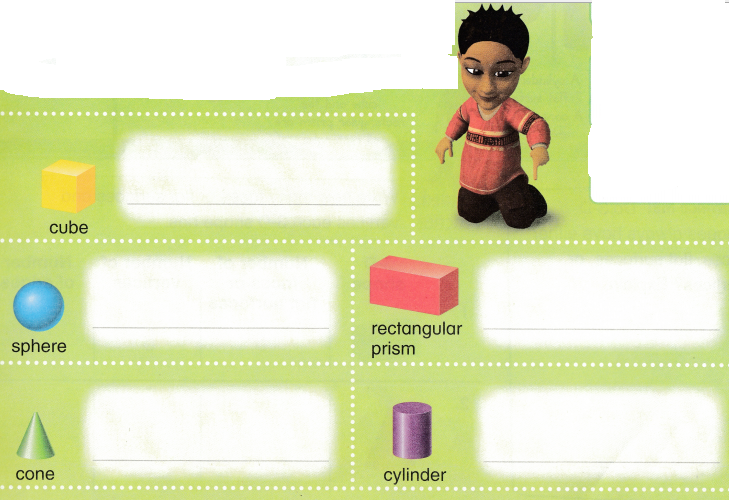
I can … define 3-D shapes by their number of edges, vertices, and faces or flat surfaces.
Visual Learning Bridge

Convince Me! Do 3-D shapes always have either faces, flat surfaces, or vertices? Explain.
Guided Practice
Write how many faces or flat surfaces and vertices each 3-D shape has.
Question.

Answer:

Explanation:
1. A rectangular prism has 8 vertices, 12 sides and 6 rectangular faces. All the opposite faces of a rectangular prism are equal. A rectangular prism has a rectangular cross section.
2. A cone is a shape formed by using a set of line segments or the lines which connects a common point, called the apex or vertex, to all the points of a circular base (which does not contain the apex). A cone has one flat surface, one vertex, and 0 edges.
Independent Practice
Write how many faces or flat surfaces, vertices, and edge each object has.
Question.

Answer:

Explanation:
3. A sphere is a three-dimensional figure (solid figure), which is made up of all points in the space, which lie at a constant distance called the radius, from a fixed point called the center of the sphere. A Sphere has Zero vertices, zero faces, and zero edges.
4. In geometry, a cube is a three-dimensional solid object bounded by six square faces, facets, or sides, with three meetings at each vertex. It has 6 faces, 12 edges, and 8 vertices.
5. The above image has two flat surfaces, zero vertices, and 2 edges.
Question 6.
Higher Order Thinking Lily has an object that looks like a 3-D shape. The object has 2 flat surfaces and 0 vertices.
Draw an object that Lily could have.
Answer:

The above object has two flat surfaces and zero vertices. The object is a cylinder.
Explanation:
In mathematics, a cylinder is a three-dimensional solid that holds two parallel bases joined by a curved surface, at a fixed distance. These bases are normally circular in shape (like a circle) and the center of the two bases are joined by a line segment, which is called the axis. The cylinder has two flat surfaces and zero vertices.
Problem Solving
Solve each problem below.
Question 7.
This shape is a cone. Which shape below is also a cone? How do you know?

Answer:

Explanation:
In the above we can observe three shapes. First is cylinder, second is cone and third also cone. A cone is a shape formed by using a set of line segments or the lines which connects a common point, called the apex or vertex, to all the points of a circular base (which does not contain the apex). The distance from the vertex of the cone to the base is the height of the cone. The circular base has measured value of radius. Cone has one flat surface and one vertex and zero edges.
Question 8.
Reasoning Nikki and Ben each buy I item from the store. Nikki’s item has 4 more edges than vertices. Ben’s item has the same number of flat surfaces and edges. Draw a circle around Nikki’s item. Draw a box around Ben’s item.

Answer:

Explanation:
Nikki and Ben each buy one item from the store. Nikki’s item has 4 more edges than vertices. Ben’s item has the same number of flat surfaces and edges.
Nikki’s item has 8 vertices and 12 edges. The shape is a rectangular prism. So draw a circle for Nikki’s item.
Ben item has 2 flat surfaces and 2 edges. Draw a box to the ben’s item.
Question 9.
Higher Order Thinking Draw and label a 3-D shape. Then write a sentence describing your 3-D shape.
Answer:

The above 3D shape is a cube.
Explanation:
In geometry, a cube is a three-dimensional solid object bounded by six square faces, facets or sides, with three meeting at each vertex. It has 6 faces, 12 edges, and 8 vertices.
Question 10.
Assessment Practice I have 6 faces. I have 8 vertices. Which 3-D shape could I be? Choose two that apply.
☐ sphere
☐ cube
☐ rectangular prism
☐ cylinder
Answer:
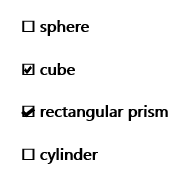
Explanation:
A rectangular prism has 8 vertices, 12 sides and 6 rectangular faces. All the opposite faces of a rectangular prism are equal. A rectangular prism has a rectangular cross section.
A Cube is a solid three-dimensional figure, which has 6 square faces, 8 vertices and 12 edges.
Lesson 14.7 Defining and Non-Defining Attributes of 3-D Shapes
Solve & Share
Measure the lengths of the cylinders. How could you make a tower 10 cubes tall using some of the cylinders? Tell what shape the tower would be.
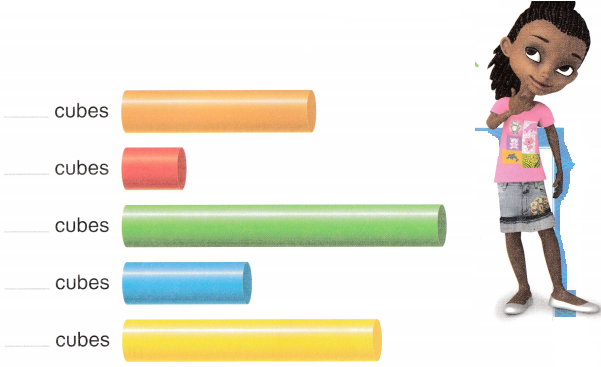
I can … choose the defining attributes of 3-D shapes.
Visual Learning Bridge

Convince Me! Write 2 things that are true about all rectangular prisms. Write 2 things that do not define rectangular prisms.
Guided Practice
Circle the words that are true for the shape.
Question 1.
All cones:

Independent Practice
Circle the words that are true for each shape.
Question 2.
All cubes:

have 12 edges.
have 8 vertices.
cannot roll.
are blue.
Answer:

Explanation:
A Cube is a solid three-dimensional figure, which has 6 square faces, 8 vertices and 12 edges. Draw a circle for the above words. All cubes have 12 edges and 8 vertices. All cubes cannot roll.
Question 3.
All cylinders:

have 2 flat surfaces.
cannot roll.
are red.
can roll.
Answer:

Explanation:
In mathematics, a cylinder is a three-dimensional solid that holds two parallel bases joined by a curved surface, at a fixed distance. These bases are normally circular in shape (like a circle) and the center of the two bases are joined by a line segment, which is called the axis. Draw a circle for the above words. All cylinder have two flat surface and all cylinders can roll.
Question 4.
en Vision® STEM Kevin wants to build a wall. Circle the 3-D shape or shapes he could stack to build the wall.

Answer:

Explanation:
STEM Kevin can build the wall with these two shape one is cube and other one is rectangular prism.
In geometry, a cube is a three-dimensional solid object bounded by six square faces, facets or sides, with three meeting at each vertex. The cube is the only regular hexahedron. It has 6 faces, 12 edges, and 8 vertices.
A rectangular prism has 8 vertices, 12 sides and 6 rectangular faces. All the opposite faces of a rectangular prism are equal. A rectangular prism has a rectangular cross section.
Problem Solving
Solve the problems below.
Question 5.
Explain Do all cubes have the same number of edges?
Yes
No
Answer:
Yes all cubes have the same number of edges.
Explanation:
A cube has sides of equal length and each vertex forms a right angle between the edges. Hence, a cube has 6 faces, 12 edges, and 8 vertices. So all cubes have the same number of edges.
Explain or draw a picture to show how you know.
Answer:

Explanation:
A cube has sides of equal length and each vertex forms a right angle between the edges. Hence, a cube has 6 faces, 12 edges, and 8 vertices.
Question 6.
Higher Order Thinking Steve says that both of these shapes are the same because they both have 6 faces and both are purple. Do you agree? Explain.

Answer:
Question 7.
Assessment Practice Match each shape with the words that describe it.

Answer:

Explanation:
A rectangular prism has 8 vertices. So match the rectangular prism with the 8 vertices.
A cube has 6 equal faces. So match the cube with the 6 equal faces.
A sphere has no flat surfaces or vertices. So match the sphere with the no flat surfaces or vertices.
A cone has one vertex. So match the cone with one vertex.
Lesson 14.8 Compose with 3-D Shapes
Solve & Share
Use green cubes to build two different rectangular prisms. Draw and write about the shapes you made. How many cubes did you use to build both rectangular prisms?

I can … put 3-D shapes together to make another 3-D shape.
Visual Learning Bridge

Convince Me! How can you find the 3-D shapes that make an object?
Guided Practice
Circle the 3-D shapes that could be put together to make the object.
Question 1.

Question 2.

Answer:

Explanation:
The 3-D shapes that makes an above object are rectangular prism and cube. Draw a circle for the 3-D shapes that could be put together to make the object are rectangular prism and cube.
A rectangular prism has 8 vertices, 12 sides and 6 rectangular faces. All the opposite faces of a rectangular prism are equal. A rectangular prism has a rectangular cross section.
In geometry, a cube is a three-dimensional solid object bounded by six square faces, facets or sides, with three meeting at each vertex.
Independent Practice
Circle the 3-D shapes that could be put together to make the object.
Question 3.

Answer:

Explanation:
The 3-D shapes that makes an above object are rectangular prism, cube, cylinder, and sphere. Draw a circle for the 3-D shapes that could be put together to make the object are rectangular prism, cube, cylinder, and sphere.
A rectangular prism has 8 vertices, 12 sides and 6 rectangular faces. All the opposite faces of a rectangular prism are equal. A rectangular prism has a rectangular cross section.
A cube is a three-dimensional solid object bounded by six square faces, facets or sides, with three meeting at each vertex.
A cylinder is a three-dimensional solid that holds two parallel bases joined by a curved surface, at a fixed distance. These bases are normally circular in shape (like a circle) and the center of the two bases are joined by a line segment, which is called the axis.
A sphere is a three-dimensional figure (solid figure), which is made up of all points in the space, which lie at a constant distance called the radius, from a fixed point called the center of the sphere.
Question 4.

Answer:

Explanation:
The 3-D shapes that makes an above object are rectangular prism, cylinder, and cone. Draw a circle for the 3-D shapes that could be put together to make the object are rectangular prism, cylinder, and cone.
A rectangular prism has 8 vertices, 12 sides and 6 rectangular faces. All the opposite faces of a rectangular prism are equal. A rectangular prism has a rectangular cross section.
A cylinder is a three-dimensional solid that holds two parallel bases joined by a curved surface, at a fixed distance. These bases are normally circular in shape (like a circle) and the center of the two bases are joined by a line segment, which is called the axis.
A cone is a shape formed by using a set of line segments or the lines which connects a common point, called the apex or vertex, to all the points of a circular base (which does not contain the apex). The distance from the vertex of the cone to the base is the height of the cone. The circular base has measured value of radius.
Question 5.

Answer:

Explanation:
The 3-D shapes that makes an above object are cylinders. Draw a circle for the 3-D shapes that could be put together to make the object are cylinder.
A cylinder is a three-dimensional solid that holds two parallel bases joined by a curved surface, at a fixed distance. These bases are normally circular in shape (like a circle) and the center of the two bases are joined by a line segment, which is called the axis.
Question 6.
Higher Order Thinking Jon wants to combine 6 green cubes to make a bigger cube. Can Jon do this? Explain. Use cubes to help.
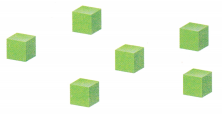
Answer:

Jon can combine 6 green cubes to make bigger cube.
Explanation:
Jon can combine 6 green cubes to make bigger cube. In geometry, a cube is a three-dimensional solid object bounded by six square faces, facets or sides, with three meeting at each vertex. The cube is the only regular hexahedron. It has 6 faces, 12 edges, and 8 vertices.
Problem Solving
Solve the problems below.
Question 7.
Make Sense Ralph made this shape below with 3-D shapes.

What 3-D shapes did Ralph use?
Answer:
Ralph used two cones and one cylinder.
Explanation:
Ralph used two cones and one cylinder.
A cylinder is a three-dimensional solid that holds two parallel bases joined by a curved surface, at a fixed distance. These bases are normally circular in shape (like a circle) and the center of the two bases are joined by a line segment, which is called the axis.
A cone is a shape formed by using a set of line segments or the lines which connects a common point, called the apex or vertex, to all the points of a circular base (which does not contain the apex). The distance from the vertex of the cone to the base is the height of the cone.
Question 8.
Make Sense Kirsten has 12 ice cubes. She wants to combine the ice cubes to make an ice sculpture.

What 3-D shape could Kirsten make with the ice cubes?
Answer:
Kristen can make a 3D shape with ice cubes is rectangular prism.
Explanation:
A rectangular prism has 8 vertices, 12 sides and 6 rectangular faces. All the opposite faces of a rectangular prism are equal. A rectangular prism has a rectangular cross section. Rectangular prisms can be of two types, namely right rectangular prism and non-right rectangular prisms.
Question 9.
Higher Order Thinking Ellen uses two of the same shape to build a bigger 3-D shape. Her new figure has 2 flat surfaces and O vertices.
What 2 shapes did Ellen use?
_________________
What bigger shape did Ellen build?
__________________
Answer:
Ellen used two same shape cylinders to build a bigger 3D shape.
The bigger shape is cylinder. A cylinder has 2 flat surfaces and 0 vertices.
Explanation:
In mathematics, a cylinder is a three-dimensional solid that holds two parallel bases joined by a curved surface, at a fixed distance. These bases are normally circular in shape (like a circle) and the center of the two bases are joined by a line segment, which is called the axis.
Question 10.
Assessment Practice Which object could be made with a ![]() and a
and a ![]() ?
?

Answer:

Explanation:
The object that could be made with both cone and cylinder is crayon. Put a tick mark to the option A.
Lesson 14.9 Problem Solving
Make Sense and Persevere
Solve & Share
Draw an X on all the objects that have flat surfaces that are circles. Tell how you know the flat surfaces are circles. Make sense of the problem by circling the words that are true about the objects you crossed out.

I can … make sense of problems.
Thinking Habits What am I asked to find? What else can I try if I get stuck?

Visual Learning Bridge

Convince Me! What words can always be used to describe a rectangular prism?
Guided Practice
Circle the words that are true of the shapes.
Question 1.
All of these shapes are squares.

Independent Practice
Circle the words that are true of the shapes. Then explain how you know.
Question 2.
All of these shapes are cones.

All cones:
are blue
have I flat surface
have I edge
have | vertex
Answer:

Explanation:
A cone is a shape formed by using a set of line segments or the lines which connects a common point, called the apex or vertex, to all the points of a circular base (which does not contain the apex). The distance from the vertex of the cone to the base is the height of the cone. The circular base has measured value of radius. All cones have one flat surface and one vertex.
Question 3.
All of these shapes are hexagons.

All hexagons:
are small
have 6 sides
are blue
have 6 vertices
Answer:

Explanation:
Hexagon is a two-dimensional geometrical shape which is made of six sides, having the same or different dimensions of length. All hexagons have 6 sides and 6 vertices.
Problem Solving
Performance Task
Arts and Crafts Wes has cubes, spheres, cylinders, and cones. He wants to use these shapes to make art pieces for an arts and crafts sale at his school.

Wes wants to put together the right shapes for each piece of art.
Question 4.
Be Precise Wes wants to put together one shape that has 6 faces and one shape that has no flat surfaces. What shapes can he use? Explain.
Answer:
He uses cube and sphere. The one shape that has 6 faces is called as cube and the one shape that has no flat surfaces is called as sphere.
Explanation:
In geometry, a cube is a three-dimensional solid object bounded by six square faces, facets or sides, with three meeting at each vertex.
A sphere is a three-dimensional figure (solid figure), which is made up of all points in the space, which lie at a constant distance called the radius, from a fixed point called the center of the sphere.
Question 5.
Reasoning Wes puts two cubes together to make a new shape. Tell what shape Wes made and one thing that is true about the new shape.
Answer:
Topic 14 Fluency Practice Activity
Show the Word
Color these sums and differences. Leave the rest white.

I can … add and subtract within 10.

The word is
________ __________ ____________
Answer:

The word is OFF
Explanation:
By coloring these sums and differences we got the word as OFF. For one I colored blue, for two I colored orange and for three I colored green.
Topic 14 Vocabulary Review
Understand Vocabulary
Word List
• 2-D shape
• 3-D shape
• attributes
• cone
• cube
• cylinder
• edge
• face
• flat surface
• rectangle
• rectangular prism
• side
• sphere
• square
• triangle
• vertex/ vertices
Question 1.
Put an X on the 2-D shape that has no vertices. Circle the 2-D shape that has 4 vertices and 4 equal sides.

Answer:

Explanation:
Here I put X to the circle because it has no vertices. A circle is a closed two-dimensional figure in which the set of all the points in the plane is equidistant from a given point called “center”.
Here I drawn a circle for square because it has four vertices and 4 equal sides. Square is a regular quadrilateral, which has all the four sides of equal length and all four angles are also equal.
Question 2.
Write what part of the shape is shown. Use the Word List.

Answer:
In the above image we can observe a flat surface of the cone.
Explanation:
In the above image the arrow points to the flat surface of the cone. A cone is a shape formed by using a set of line segments or the lines which connects a common point, called the apex or vertex, to all the points of a circular base(which does not contain the apex).
Question 3.
Complete the name of the shape. Use the Word List to help you.

________ prism
Answer:
The name of the above shape is rectangular prism.
Explanation:
In the above image we can observe a rectangular prism. A rectangular prism is a three-dimensional shape. It has six faces, and all the faces of the prism are rectangles. Both the bases of a rectangular prism must be a rectangle. Also, the other lateral faces will be rectangles. It is also called a cuboid.
Use Vocabulary in Writing
Question 4.
Draw some shapes. Label the shapes using words from the Word List.
Answer:

Explanation:
From the above word list I draw some shapes. Here I draw two 2D shapes and two 3D shapes. In 2D shapes I draw square and triangle. In 3D shapes I draw sphere and cone as we can observe in the above image.
Topic 14 Reteaching
Set A
You can define 2-D shapes by their attributes.
A hexagon must be a closed figure. It must have 6 sides and 6 vertices.

Color, overall size, or position do not define a shape.
Solve each problem below.
Question 1.
Circle the shape that has 4 straight sides and 4 vertices.

Answer:

Explanation:
In the above shapes I draw a circle for rectangle shape because it has four straight sides and 4 vertices. A rectangle is a two-dimensional figure, which has four sides (Quadrilateral) and four corners/vertices. All the interior angles are equal, which measures 90 degrees. The opposite sides of a rectangle are parallel and are of equal measure.
Question 2.
Circle the shape that has 0 vertices.

Answer:

Explanation:
In the above shapes I draw a circle for circle shape because it has 0 vertices. A circle is a closed two-dimensional figure in which the set of all the points in the plane is equidistant from a given point called “center”.
Set B
You can make 2-D shapes using different kinds of materials.

Use materials your teacher gives you to make a rectangle. Glue or tape it in the box.
Question 3.
Answer:
Set C
You can use pattern blocks to make a larger shape.
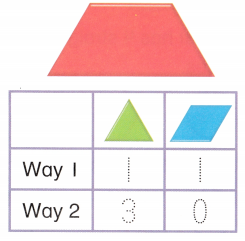
Question 4.
Make this shape in two different ways.

Answer:
Set D
You can use pattern blocks to make a picture.

Write the number of blocks you used.

Question 5.
Make a picture. Write how many of each block you used.

Answer:
Set E
Reteaching Continued
You can find faces, flat surfaces, edges, and vertices on 3-D shapes or objects.

Write how many flat surfaces, edges, and vertices for each shape.
Question 6.

_________ flat surfaces
________ vertices
________ edges
Answer:
A cylinder has 2 Flat surfaces, 0 vertices and 2 edges.
Explanation:
A cylinder is a three-dimensional solid that holds two parallel bases joined by a curved surface, at a fixed distance. These bases are normally circular in shape (like a circle) and the center of the two bases are joined by a line segment, which is called the axis. A cylinder has 2 Flat surfaces, 0 vertices and 2 edges.
Question 7.

_________ flat surfaces
________ vertices
________ edges
Answer:
A cone has 1 flat surfaces and 1 vertices and 0 edges.
Explanation:
A cone is a shape formed by using a set of line segments or the lines which connects a common point, called the apex or vertex, to all the points of a circular base (which does not contain the apex). A cone has 1 flat surfaces and 1 vertices and 0 edges.
Set F
You can combine 3-D shapes to make bigger 3-D shapes. Combine 2 cubes.

Two shapes were combined to make a new shape. Write the number of flat surfaces, vertices, and edges for the new shape.
Question 8.

Answer:

Explanation:
A cylinder is a three-dimensional solid that holds two parallel bases joined by a curved surface, at a fixed distance. These bases are normally circular in shape (like a circle) and the center of the two bases are joined by a line segment, which is called the axis. A cylinder has a curved lateral surface and two circular faces at its ends. A cylinder has no corner or vertex. A cylinder has 2 circular edges.
Set G
All of these are cylinders.

Cylinders are defined by:
0 vertices and 2 flat surfaces.
Cylinders are NOT defined by:
Color or Direction
Finish the sentences to define spheres.

Question 9.
Spheres are defined by:
________ and _________.
Answer:
Spheres are defined by 0 vertices and 0 flat surfaces.
Explanation:
A sphere is a three-dimensional figure (solid figure), which is made up of all points in the space, which lie at a constant distance called the radius, from a fixed point called the center of the sphere. Sphere has 0 vertices and 0 flat surfaces.
Question 10.
Spheres are NOT defined by:
____________ or ___________.
Answer:
Spheres are not defined by color or directions.
Explanation:
A sphere is a three-dimensional figure (solid figure), which is made up of all points in the space, which lie at a constant distance called the radius, from a fixed point called the center of the sphere. Sphere has 0 vertices and 0 flat surfaces. Spheres are not defined by color or directions.
Set H
Thinking Habits
Persevere
What am I asked to find? What else can I try if I get stuck?

Circle the words that are true for all rectangles.

Question 11.
All rectangles:
have sides of different lengths.
are blue.
have 4 vertices.
Answer:

Explanation:
A Rectangle is a four sided-polygon, having all the internal angles equal to 90 degrees. The two sides at each corner or vertex, meet at right angles. The opposite sides of the rectangle are equal in length which makes it different from a square. It has 4 vertices.
Topic 14 Assessment Practice
Question 1.
Which shape has exactly 3 sides?
A. rectangle
B. triangle
C. circle
D. Square
Answer:
B. Triangle
Explanation:
A triangle is a polygon with three edges and three vertices. It is one of the basic shapes in geometry. Triangle is a plane figure with three straight sides and three angles.
Question 2.
How do you know if a shape is a square?
A. The shape has 0 edges and 0 vertices.
B. The shape has 3 edges and 3 vertices.
C. The shape has 4 edges and 4 vertices.
D. The shape has 4 edges that are the same length and 4 vertices.
Answer:
D. The shape has 4 edges that are the same length and 4 vertices.
Explanation:
In geometry, a square is a regular quadrilateral, which means that it has four equal sides and four equal angles. It can also be defined as a rectangle in which two adjacent sides have equal length. A square has 4 edges that are the same length and 4 vertices.
Question 3.
How many flat surfaces and edges does a cone have?
________ flat surface(s)
________ edge(s)
Answer:
Cone have 1 flat surface.
Cone have 0 edges.
Explanation:
A cone is a shape formed by using a set of line segments or the lines which connect a common point, called the apex or vertex, to all the points of a circular base (which does not contain the apex). A cone has 0 edges and has 1 flat surface.
Question 4.
Jaxon makes 3 triangles. Then he puts them together to make a new shape.
Draw a shape that Jaxon could have made.
Answer:
Question 5.
Complete the sentence. Then explain how you know you are correct.

This 3-D shape is a _________.
Answer:
This 3-D shape is a cylinder.
Explanation:
The above 3D shape is a cylinder. A cylinder is a three-dimensional solid that holds two parallel bases joined by a curved surface, at a fixed distance. These bases are normally circular in shape (like a circle) and the center of the two bases are joined by a line segment, which is called the axis.
Question 6.
Jazmin is making a butterfly. Use pattern blocks to draw in the pieces she is still missing.

Answer:

Explanation:
Jazmin is making a butterfly. She missed some pieces. By using pattern blocks we can make a butterfly. The pattern blocks are trapezium and hexagon. She missed three pieces of hexagon and one piece of trapezium. By using these shapes we can complete the butterfly shape.
Question 7.
Choose two sets of shapes you can use to make  .
.

Answer:
Question 8.
All of these shapes are triangles. Circle two ways to describe all triangles.

Answer:

Explanation:
A triangle is a polygon with three edges and three vertices. It is one of the basic shapes in geometry. All triangles have 3 sides and 3 vertices.
Question 9.
A. Which 3-D shape does NOT have a vertex?

Answer:

Explanation:
In the above image, we can observe 4 different 3D shapes. The shapes are cube, rectangular prism, cone, and cylinder. The cylinder has 0 vertices.
B. What is the name of the shape you chose in A?
Answer:
The name of the shape I choose in A is a cylinder.
Explanation:
In mathematics, a cylinder is a three-dimensional solid that holds two parallel bases joined by a curved surface, at a fixed distance. These bases are normally circular in shape (like a circle) and the center of the two bases are joined by a line segment, which is called the axis.
Question 10.
Circle the two 3-D shapes that can be used to make this object.

Answer:

Explanation:
The two 3D shapes that make the above objectives are rectangular prism and cube.
A rectangular prism has 8 vertices, 12 sides, and 6 rectangular faces. All the opposite faces of a rectangular prism are equal. A rectangular prism has a rectangular cross-section.
In Geometry, a Cube is a solid three-dimensional figure, which has 6 square faces, 8 vertices, and 12 edges.
Question 11.
A. Which 2-D shape has no straight sides?

Answer:

Explanation:
In the above image, we can observe four different 2D shapes. The shapes are Hexagon, parallelogram, square, circle. The 2D shape that has no straight sides is the circle.
B. How many vertices does your answer to A have?
Answer:
0 vertices
Explanation:
The circle doesn’t have vertices.
Question 12.
Match each 3-D shape with one way to describe it. Use each description once.

Answer:

Explanation:
A cone has 1 vertex.
A sphere has no flat surfaces.
A rectangular prism has 12 edges.
A cube has 12 edges and 6 square faces.
Topic 14 Performance Task
Home Sweet Home! Leslie uses shapes to make this drawing of her house.

Question 1.
Color two of the rectangles in the drawing blue.
Answer:

Question 2.
Explain how you know that the two shapes are rectangles.
Answer:
As parallel sides are equal we can know that it is a rectangle
Question 3.
One of the windows of the house is in the shape of a hexagon.
Show 3 ways you could make a hexagon using smaller shapes. You can use pattern blocks to help you.
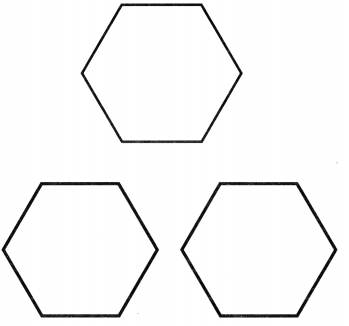
Answer:
Question 4.
Leslie has these tents in her backyard.
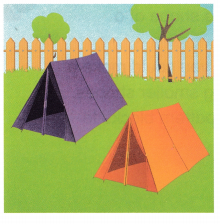
She says that the doors of both tents are the shape of a triangle because they have 3 sides and 3 vertices.
Do you agree with Leslie’s reasoning? Circle Yes or No.
Yes
No
Explain your answer.
Answer:
Yes.
Explanation:
As the tent is in triangle shape, so they have 3 sides and 3 vertices.
Question 5.
Leslie has a table in her house that is this shape.

Part A
What is the shape of her table?
Answer:
Rectangle.
Explanation:
The shape of her table is rectangle as the parallel sides are equal.
Part B
How many of each does her table have?
faces ________
edges ________
vertices ________
Answer:
Faces – 2.
Edges – 4.
Vertices – 4.
Explanation:
As the table is rectangle shape, so the number of faces of the rectangle is 2.
The edges of the rectangle is 4.
The vertices of the rectangle is 4.
Part C
What 3-D shapes could Leslie put together to make her table?
Answer:
Right rectangular prism.
Explanation:
The 3-D shapes could be right rectangular prism.